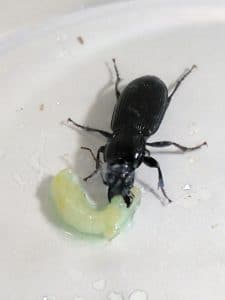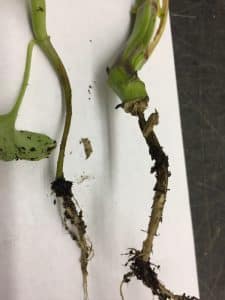The Canola Council of Canada and the provincial canola grower organizations hosted canoLABs at Regina, Sask., Vermilion, Alta., and Dauphin, Man., earlier this year. Here are the top canoLAB messages for growers and agronomists to consider through 2017.

Set a target stand. Current canola hybrids can reach their yield potential with populations as low as 4 to 6 plants per square foot. But these plants must be uniform and healthy and protected through to harvest. Growers may find that higher populations reduce the risk of yield loss due to plant loss from insects, disease, frost and other causes throughout the season. A more dense canola stand can also improve weed competition, potentially eliminating the need for a second in-crop spray. To find out the best plant population for your fields and the seeding rate that will achieve that target, try the tools at canolacalculator.ca.
Look at blackleg labels. If growers had a blackleg problem in 2016 or before, they may want to rotate varieties. A new blackleg classification system will help make an informed decision. Read more about it here.
Match soil test techniques to your region. At his station, U of S soil scientist Jeff Schoenau encouraged growers to make sure the soil testing methodology they use is appropriate for the soil types/chemistry in their region. If soil tests were not done last fall, warm early spring days present an opportunity to do them now.
Review your macro rates. Phosphorus was a focus at Alberta and Saskatchewan canoLABs, encouraging growers and agronomists to look at removal rates to maintain soil P levels. Nitrogen was the focus in Manitoba. With a late fall, some growers didn’t get a chance to make fall nitrogen applications. If they are not set up to apply all their nitrogen in one pass with their seed, how do they apply nitrogen in a timely manner? Broadcast is one solution, but an inhibitor may help reduce losses until rains move this nitrogen into the soil.

Avoid spraying during an inversion. With inversion conditions, spray mist hangs in the air and can move to land anywhere. The normal condition is that air is warmest near the surface and cools with altitude. An “inversion” is when air at the earths surface cools quickly, cooling the air immediately above the ground while warmer air remains above it, This dense stable air near the ground will suspend small droplets for longer periods, increasing the risk of off-target movement. This air is also typically humid, so those small droplets evaporate more slowly. Clear skies and low wind late in the day are signs of a potential inversion situation. “Generally, an extended period with clear or mostly clear skies during late afternoon or during the night is necessary for inversion formation because clear skies allow the maximum loss of terrestrial radiation to space. The longer the clear period, the more intense the resulting inversion will be,” said Manitoba canoLAB presenter Jim Wilson. Just a little wind — over 5 mph — can end or prevent an inversion. So can cloud cover of about 25%. NDSU’s comprehensive factsheet on inversions says: “Spraying during an inversion never is recommended, even with drift-reducing nozzles or drift retardants. Drift-reducing nozzles or drift retardants still produce some fine drops less than 200 microns in diameter that are likely to drift.”

Watch for cabbage seedpod weevil and midge. Cabbage seedpod weevil continues to move north. Growers in central Alberta and west central Saskatchewan are encouraged to keep an eye out in 2017. Midge damage is also something to get familiar with. This new midge video will help.

Take a beneficial safari. AAFC research scientist Tyler Wist’s key message: “Sweep before you spray. When you know how to identify the main beneficial insect species in your canola crop, you can decide if they warrant saving and if the pest insects are at a high enough level to warrant killing. Use this information to make informed decisions about insecticide treatments.” Two resources: Sign up for the Prairie Pest Monitoring Network email to get timely insect information during the growing season. (Find the sign up box in the top right corner.) Download the AAFC Insect Field Guide.

Refine your disease ID skills. Blackleg and root rots are often confused when assessing the base of the stem (crown and tap root) for disease. Scout throughout the growing season to properly diagnosis and identify symptoms within the crop. A plant symptom like wilting could be caused by numerous conditions such as blackleg, clubroot or drought — to name a few. Digging up plants and assessing the entire plant for symptoms and/or damage will help to diagnosis the potential issue and help to change management practices in future years. If plants symptoms cannot be determined in the field, send plants away to your provincial diagnostics lab or call in your local canola council agronomist to assist. Bonus tip: Taking plant counts post emergence and prior to harvest will help to identify how many plants were lost during the growing season. Scouting during the growing season will help to answer why these plants were lost! Find distinguishing features for each major disease at the Canola Encyclopedia. You can also try the Canola Diagnostic Tool.
Set the combine to reduce losses. PAMI’s Les Hill talked about combine settings to reduce canola harvest losses. The three most relevant take away messages were: (1) Understand the importance of measuring loss as a means to guide combine settings and improve the balance among harvest efficiency and profitability. (2) Know ways to collect and measure loss in a consistent and disciplined manner. (3) Learn the basic effects of adjusting combine components for threshing, separating and cleaning. Note that under no settings or circumstances tested did losses drop as combine ground speed increased.
Match aeration fan size to the job. Joy Agnew, the PAMI researcher who presented on fan size at canoLAB Dauphin, writes: “One question I get all the time is if a fan is sized to allow natural-air drying (NAD) for canola, if that same fan and bin are used to store another crop, will the fan be oversized? The answer is yes. You will have a much higher airflow rate with other crops if the fan is sized for canola. The next question: Is that a bad thing? It might be. First off, anything above 2.5 cfm/bu airflow rate is likely not increasing your drying capacity or drying rate. So you are paying a higher power bill for no added benefit. Secondly, very high airflow rates (above 2 cfm/bu) may result in overdrying and cracking of certain crops (such as pulses) due to the high drying rate. So high airflow rates may be detrimental for some crops. Some producers prefer to size fans for NAD of wheat and if they need to use that bin/fan for canola, they only fill the bin partway to help achieve a sufficient airflow rate. This does work, but there is an increased chance of moisture accumulating in the headspace of the bin. If a bin is only half full, there is a lot of headspace to cause problems. If they want to go this route, they may want to consider an active ventilation system (a fan at the outlet(s)) to help pull moist air out of the headspace.”
Further reading:
Read the canoLAB 2017 blog post by Alberta Canola director John Mayko

